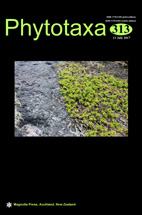Abstract
Pilea nonggangensis Y. G. Wei, L. F. Fu & A. K. Monro, a new species from Guangxi, China is described and illustrated. The new species is morphologically most similar to P. basicordata from which it differs by being dioecious, having peltate leaf blades, membranous stipules, paired inflorescences and larger bracts. Nuclear ribosomal internal transcribed spacer (ITS) region and plastid trnL-F intron spacer (trnL-F) DNA sequence data from the new species and 20 local congeneric species are used to resolve the systematic position of the new species within Pilea. Despite vastly different morphology the molecular evidence suggests that P. nonggangensis is most closely related to P. pseudonotata. A Global Species Conservation Assessment classifies P. nonggangensis as Vulnerable (VU).

